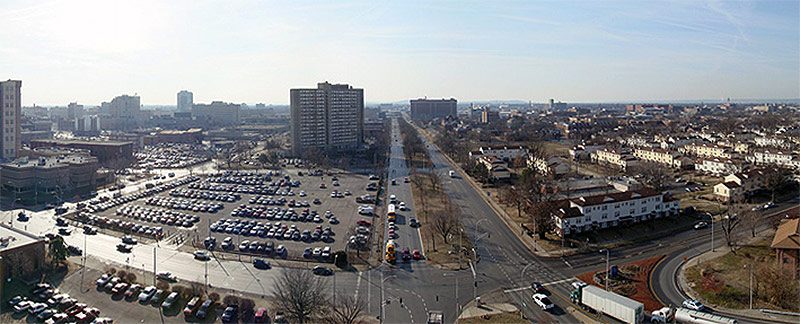It is like night and day once you cross over Ninth Street – you can see the difference in wealth, you can see the difference in investment than in other parts of the city, and you know that it literally stops at Ninth Street.”
—Haven Harrington III
Nearly every city in America has in some way grappled with the legacy of segregation. Often times, these battles would unfold in the public sphere, in areas where non-whites were not allowed in movie theaters, department stores, and—as was the case for a young Muhammad Ali—restaurants.

In Louisville, that legacy exists in many areas, but none as noticeable today as Ninth Street, which was constructed in the 1950s and ’60s as a high-traffic expressway that served to expedite car travel across the city—and to separate black and white Louisville with a wide thoroughfare. In the process, we demolished a large African-American business district and created a physical scar that continues to divide Louisville between East and West, rich and poor, black and white.
The origins of this divide are both structural and complex, but the urban design element began in 1932 when series of racist policies were rolled out that were designed to “contain the Negro Housing Problem in Louisville.” Such policies have left the city with a set of deepening issues, both physical and social.

In the third installment of KY Place, four panelists unpack the topic and break it down in new, thought-provoking ways. From the legal effort to prevent African Americans from purchasing certain properties to the media’s treatment of West Louisville, “Ninth Street Divide” is a history lesson as much as it is a social analysis. The conversation between Attica, Dana, Haven, and Joe circles around a common goal: to acknowledge our broken history and identify solutions to the problems that grew out of segregation.
Featuring: Dana Duncan (Instructor, Jefferson Community & Technical College); Haven Harrington III (President, Russell Neighborhood Association); Joe Dunman (Civil rights attorney); and Attica Scott (Representative-elect, Kentucky House of Representatives, District 41).


Excellent film, but it was a little strange to see vignettes from South and East Louisville in a film discussing the Ninth Street Divide….
I don’t want to be critical, but instead just a critique.
This was a bit of a perplexing project to watch.
It’s the filming of a panel discussion, (which is not really a film… Its just the filming of a discussion, interspersed with photography of somewhat randomly chosen locations), nor does it express any opinions, unique views or suggestions from it’s creator(s). Then, at the screening, it was followed by a panel discussion on the panel discussion, about the panel discussion. There were some interesting loose points from the panel regarding how the 9th street divide happened (kind-of), but no real delivery of a message or even a proposed solution.
The only real take away was essentially to try to work with your local government.
As far as “not being from Louisville”, its an interesting argument I hear A LOT. However, it’s largely people “from here” that created the current issues / problems. Maybe, what could be best utilized are ideas from the “outside” from places that have actually solved these type if problematic situations. Also, most of the investment *actually* happening (investment of money, effort and risk amongst other things), is almost exclusively coming from outsiders, save a number of “charities” and religious efforts… Both exempt from tax and other things that brace your local economy and pull state and federal monies away from other progressive necessities.
It’s interesting. A lot of the problems here are neither unique or particularly challenging, and automatically rejecting any opinions from “outsiders”, is probably a contributing factor in why things are they way they are.
If Louisville was serious about solving / correcting problems like this ( I’m referring specifically to the disaster of urban planning that IS the “9th Street Divide”, they’d simply DO it. The way it happened might be convoluted, and might seem too complex a problem for many. But…. As the old saying goes, “How does a rat eat an elephant? One bite at a time”. Problem is, no one is hungry enough for positive, effective change here to truly commit to it.